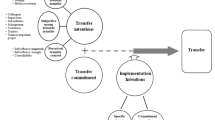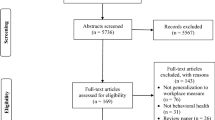Abstract
A number of factors influence the outcomes of computer skills training and the likelihood of successful transfer. The first empirical test of a conceptual model of training transfer sought to explain how trainees' perceptions of various in-training transfer-enhancing activities such as overlearning, fidelity, stimulus variability, principles-meaningfulness, self-management activities, relapse prevention, and goal setting would predict the self-efficacy and implementation intentions (rather than actual transfer outcomes) of computer skills trainees. As expected, posttraining self-efficacy and transfer enhancing activities both predicted transfer implementation intentions. Pretraining self-efficacy also significantly predicted posttraining self-efficacy, trainees' level of learning during training and transfer enhancing activities, providing support for the conceptual model of training transfer.
Similar content being viewed by others
REFERENCES
Arbuckle, J. L. (1999). Amos for Windows. Analysis of moment structures. Version 4.01. Chicago, IL: Smallwaters Corporation.
Baldwin, T. T. & Ford, J. K. (1988). Transfer of training: A review and directions for future research. Personnel Psychology, 41, 63-105.
Cannon-Bowers, J. A., Salas, E., Tannenbaum, S. I., & Mathieu, J. E. (1995). Toward theoretically based principles of training effectiveness: A model and initial empirical investigation. Military Psychology, 7, 141-164.
Clark, L.A., & Watson, D. (1991). General affective dispositions in physical and psychological health. In C.R. Snyder & D.R. Forsyth (Eds.), Handbook of social and clinical psychology (pp. 221-245). New York: Pergamon Press.
Colquitt, J. A., LePine, J. A., & Noe, R. A. (2000). Towards an integrative theory of training motivation: A meta-analytic path analysis of 20 years of research. Journal of Applied Psychology, 85, 678-707.
Compeau, D. R., & Higgins, C. A. (1995). Application of social cognitive theory to training for computer skills. Information Systems Research, 6, 118-143.
Compeau, D. R., Higgins, C. A., & Huff, S. (1999). Social cognitive theory and individual reactions to computing technology: A longitudinal study. MIS Quarterly, 23, 145-158.
Fogarty, G. J., Machin, M. A., Albion, M. J., Sutherland, L. F., Lalor, G. I., & Revitt, S. (1999). Predicting occupational strain: The role of stress, coping, and positive and negative affectivity. Journal of Vocational Behavior, 54, 429-452.
Ford, J. K. (1997). Transfer of training: The criterion problem. Applied Psychology: An International Review, 46, 349-354.
Foxon, M. J. (1997). The influence of motivation to transfer, action planning, and manager support on the transfer process. Performance Improvement Quarterly, 10(2), 42-63.
Gattiker, U. E. (1992). Computer skills acquisition: A review and future directions for research. Journal of Management, 8, 547-574.
Gick, M. L., & Holyoak, K. J. (1987). The cognitive basis of knowledge transfer. In S. M. Cormier & J. D. Hagman (Eds.), Transfer of learning: Contemporary research and applications (pp. 9-46). San Diego: Academic Press.
Gist, M. E., Stevens, C. K. & Bavetta, A. G. (1991). Effects of self-efficacy and post-training intervention on the acquisition and maintenance of complex interpersonal skills. Personnel Psychology, 44, 837-861.
Gollwitzer, P. M. (1993). Goal achievement: The role of intentions. In W. Stroebe & M. Hewstone (Eds.), European review of social psychology (Vol. 4, pp. 141-185). Chichester, England: Wiley.
Gollwitzer, P. M. (1999). Implementation intentions: Strong effects of simple plans. American Psychologist, 54, 493-503.
Graham, J. W., & Donaldson, S. I. (1993). Evaluating interventions with differential attrition: The importance of nonresponse mechanisms and use of follow-up data. Journal of Applied Psychology, 78, 119-128.
Hambleton, R. K., Swaminathan, H., & Rogers, H.J. (1991). Fundamentals of item response theory. Newbury Park, CA: Sage.
Hesketh, B. (1997a). Dilemmas in training for transfer and retention. Applied Psychology: An International Review, 46, 317-339.
Hesketh, B. (1997b). W(h)ither dilemmas in training for transfer. Applied Psychology: An International Review, 46, 380-386.
Holding, D. H. (1991). Transfer of training. In J. E. Morrison, (Ed). Training for performance: Principles of applied human learning (pp. 93-125). Chichester: John Wiley & Sons.
Hu, L., & Bentler, P.M. (1999), Cutoff criteria for fit indexes in covariance structure analysis: Conventional criteria versus new alternatives. Structural Equation Modelling, 6, 1-55.
Klein, K. J., & Ralls, R. S. (1997). An exploration of the unintended organizational consequences of technology training: Implications of practice for training theory and research. In J. K. Ford, S. W. J. Kozlowski, K. Kraiger, E. Salas, & M. Teachout (Eds.), Improving training effectiveness in work organizations (pp. 323-355). Hillsdale, NJ: Lawrence Erlbaum Associates.
Kraiger, K., Ford, J. K., & Salas, E. (1993). Application of cognitive, skill-based, and affective theories of learning outcomes to new methods of training evaluation. Journal of Applied Psychology [Monograph], 78, 311-328.
Machin, M. A., & Fogarty, G. J. (1997). The effects of self-efficacy, motivation to transfer, and situational constraints on transfer intentions and transfer of training. Performance Improvement Quarterly, 10(2), 98-115.
Machin, M. A., & Fogarty, G. J. (2003). The structure of transfer climate and its role in influencing pre-training self-efficacy and motivation. Manuscript submitted for publication.
McGehee, W., & Thayer, P. W. (1961). Training in business and industry. New York: Wiley.
Roth, P. L. (1994). Missing data: A conceptual review for applied psychologists. Personnel Psychology, 47, 537-560.
Saks, A. M. (1997). Transfer of training and self-efficacy: What is the dilemma? Applied Psychology: An International Review, 46, 365-370.
Schafer, J. L. (1997). Analysis of incomplete multivariate data. New York: Chapman and Hall.
Simon, S. J., Grover, V., Teng, J. T. C., & Whitcomb, K. (1996). The relationship of information system training methods and cognitive ability to end user satisfaction, comprehension and skill transfer: A longitudinal field study. Information Systems Research, 7, 466-490.
Simon, S. J., & Werner, J. M. (1996). Computer training through behavior modeling, selfpaced, and instructional approaches: A field experiment. Journal of Applied Psychology, 81, 648-659.
Thayer, P. W., & Teachout, M. S. (1995). A Climate for Transfer Model. AL/HR-TP-1995-0035, Brooks Air Force Base, Texas.
Tubbs, M. E., & Ekeberg, S. E. (1991). The role of intentions in work motivation: Implications for goal-setting theory and research. Academy of Management Review, 16, 180-199.
Tziner, A., Haccoun, R. R. & Kadish, A. (1991). Personal and situational characteristics influencing the effectiveness of transfer of training improvement strategies. Journal of Occupational Psychology, 64, 167-177.
Venkatesh, V., & Speier, C. (1999). Computer technology training in the workplace: A longitudinal investigation of the effect of mood. Organizational Behavior and Human Decision Processes, 79(1), 1-28.
Watson, D., Clark, L. A., & Tellegen, A. (1988). Development and validation of brief measures of positive and negative affect. Journal of Personality and Social Psychology, 54, 1062-1070.
Wexley, K. N. & Baldwin, T. T. (1986). Post-training strategies for facilitating positive transfer: An empirical exploration. Academy of Management Journal, 29, 503-520.
Author information
Authors and Affiliations
Corresponding author
Rights and permissions
About this article
Cite this article
Machin, M.A., Fogarty, G.J. Perceptions of Training-Related Factors and Personal Variables as Predictors of Transfer Implementation Intentions. Journal of Business and Psychology 18, 51–71 (2003). https://doi.org/10.1023/A:1025082920860
Issue Date:
DOI: https://doi.org/10.1023/A:1025082920860




